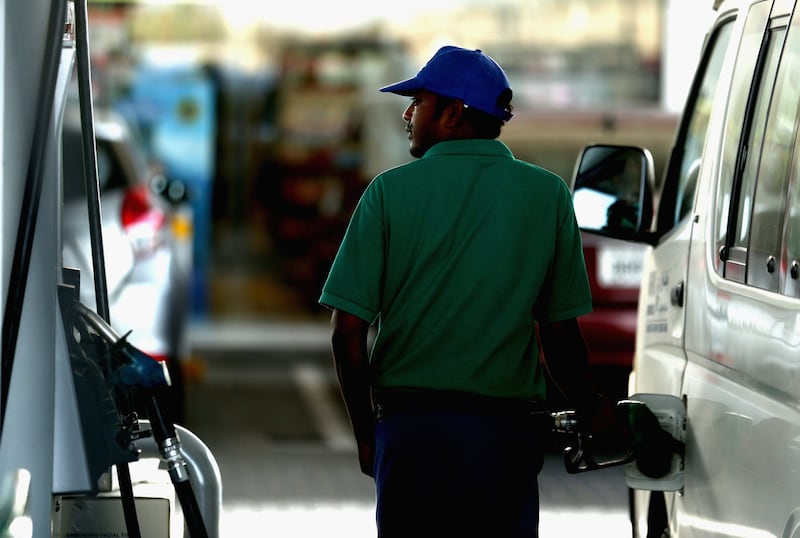The price of petrol in the UAE will increase next month while diesel is set to cost less, the UAE fuel price committee announced on Sunday.
Prices rose in March and February after dropping in November, December and January, reflecting the trend in the global oil market.
How much will fuel cost in April?
The breakdown in fuel price per litre for April is as follows:
• Super 98: Dh3.15, from Dh3.03 in March (up by 4 per cent)
• Special 95: Dh3.03, from Dh2.92 in March (up by 3.7 per cent)
• Diesel: Dh3.09, from Dh3.16 in March (down by 2.2 per cent)
• E-plus 91: Dh2.96, from Dh2.85 in March, (up by 3.8 per cent)
The UAE liberalised fuel prices in 2015 to allow them to move in line with the market. In 2020, prices were frozen after the start of the Covid-19 pandemic.
The controls were lifted in March 2021 to reflect the movement of the market once again.
Oil prices recorded a strong gain in the first quarter of the year amid Opec+ output cuts and rising fears of supply disruption due to geopolitical risks.
Oil prices have risen by about 11 per cent since the beginning of the year due to Opec+ supply cuts and geopolitical uncertainty arising from Ukrainian drone attacks on Russian oil infrastructure.
Looking ahead, the balance between supply and demand in the market will depend on decisions made by the Opec+ alliance.
“We expect Brent to grind higher until $90 or until we reach June, supported by geopolitical tension which has shifted back to Russia-Ukraine, as well as a healthy debate on global balances,” said Vikas Dwivedi, Macquarie’s global energy strategist, last week.
“If Brent reaches $90, we believe most of the upside will be factored into oil and the remaining unpriced fundamental factors, mostly supply growth related, will largely be bearish,” he said.
The Opec+ alliance recently extended voluntary cuts of 2.2 million barrels per day into the second quarter to stabilise oil markets.
The group will hold an online meeting on April 3 to review oil market conditions. A full ministerial gathering will be held in Vienna in June.
Another key factor to monitor will be the impact of the Russia-Ukraine war on oil supply.
On March 24, Russia unleashed a barrage of missiles on Ukraine’s western region of Lviv. The assault on Ukraine followed recent attacks on Russian oil infrastructure, with several crude refineries hit in drones strikes this month alone.
While the damage at most energy complexes has been repaired quickly, between 600,000 to 900,000 barrels per day of refining capacity is set to remain offline for “several weeks to months”, Japanese lender MUFG said in a report this month.
In the Middle East, Houthis continued to attack commercial vessels in the Red Sea, hitting Chinese-owned oil tanker Huang Pu, the US military said earlier.
Israel has also continued its attacks in Gaza, as chief negotiators to the truce talks have left Qatar without making tangible progress towards a deal to pause the fighting.
Earlier this month, the International Energy Agency projected global oil markets to be in a supply deficit this year instead of the surplus as previously predicted, with Opec+ supply cuts expected to continue into the second half of the year.
The agency's projection was based on the assumption that the voluntary cuts by Opec+ will remain in effect until the end of 2024 unless there is confirmation from the producers' alliance indicating otherwise.
The agency also raised its annual oil demand growth forecast, citing higher-than-expected crude consumption of 1.7 million bpd in the first quarter.
It expected oil demand to grow by 1.3 million bpd in 2024, up from its previous estimate of about 1.2 million bpd, but significantly lower than the expansion of 2.3 million bpd recorded last year.
The projection reflects slowing fuel demand in China as well as efficiency gains and rising adoption of electric vehicles worldwide, the agency said.
The forecast has also narrowed the gap to Opec’s estimate of 2.2 million bpd growth this year. Opec has taken a more positive view of the oil markets and expects higher economic growth in the US and India to drive consumption.
Earlier this month, Opec raised its estimate for global economic growth this year by 0.1 per cent to 2.8 per cent, citing “robust” economic expansion in the second half of 2023.
Opec also said that the extension of voluntary cuts by the Opec alliance, which includes Russia, would lead to non-Opec crude production growing by 1.1 million bpd this year, down 120,000 bpd from the group’s previous projection.
“We think the oil market will tighten already next quarter, driven by voluntary production cuts of O pec member states and lower Russian production, while oil demand remains healthy,” said Giovanni Staunovo, strategist at UBS earlier this month.







